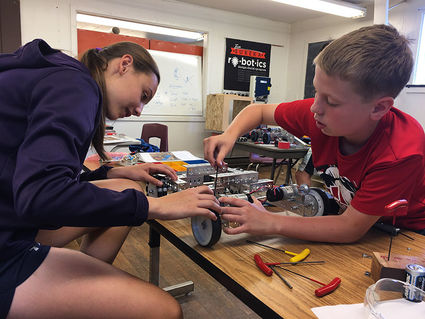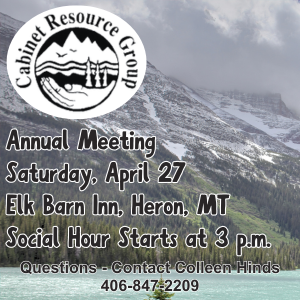Falls seventh graders learn in Robotics competition
July 12, 2018

Courtesy Photo
TEAMING UP to get things just right, Hattie Neesvig and Theo Nygaard work on a robotics project together in Eureka on Tuesday.
Some people never stop playing with toys. For seventh grade students, it is the cusp of a rite of passage for those who have spent their early childhoods playing with Legos and young adolescence in Lego robotics competitions – the Science, Technology, Engineering, Math (STEM) based league that introduces youth to robotics and computer programming.
Thompson Falls science educator Erik Nygaard is in his fifth year coaching competitive robotics, including building with Legos in the First Lego League (FLL). While he is always seeking new professional development in that arena, he also wanted students in that sport to be able to get an edge on the game.
"At this age, students move up to actual robotics and programming," said Nygaard from his father's property in Eureka where he and five Thompson Falls students are camping in the basement, "we're graduating from the simple building blocks of Legos and block coding to actual robots and real JAVA coding. This is the same code used by Android app developers – it's the real deal."
The Falls budding programmers are in Eureka for a five-day crash course introducing them to the big leagues of robotics to be able to compete effectively in the FIRST Tech Challenge. The season for that competition begins in September, with statewide competition in January.
Nygaard admits that his knowledge in the sport can always be improved, so he has enlisted the help of outside experts in that field for the fifth year of the camp. "We have Rob Reynolds, who is the tech coordinator at Eureka schools. He's an impressive individual who seems to have lived a million lives – and has been involved with Eureka's robotics team, which has always been a few steps ahead of ours."
Known as "Rocket Man" for his knowledge and abilities in the field, Reynolds is joined by Dan Jankowski of Helena – who has little experience in the sport, but is a computer programmer by trade. The two are a wealth of knowledge for the team and, with the help of student mentors from Helena, are guiding camp participants in their quest for victory in the upcoming season.
"The games aren't 'battle-bot,' destructive style like you see on television," explained Nygaard, "but a natural progression from our days in Lego robotics." Participants are accustomed to having a robot arena to themselves in competitions, programming designed robots to accomplish tasks laid out by the league in the pre-season. Points are scored and times are kept to determine ranking. "In this more advanced league, we share the 12 foot by 12 foot arena with three other team's robots – two opposing and one ally team. There are rules about certain interference, but the energy is entirely different during battle."

While the actual tasks for the season are kept secret until commencement, the league does drop hints so that, nationwide, competitors know what to work on. "We've decided to do an actual "battle-bot" type scenario here at the camp, just because it is so popular and exciting. But we aren't destroying each other's bots (since parts are so expensive), but we are putting a kill-switch on them that, when pressed by an opposing bot, will make their program malfunction and stop."
The camp is designed with three components covered: building and design, 3D printing and CAD programs, and task accomplishment (making the robot stack plastic bricks or collecting balls and throwing them through a hoop).
"There is a lot of wiggle room in the rules for defense and protection of the bot, as well as tools to make it accomplish the required tasks. That allows for a lot of creativity and problem solving within the team," shared Nygaard, "the great part is the integration of 3D printing. If we decide we need a certain part to add to the robot, we design it in the CAD program and print it up on the spot."
Students who graduate from high school with a background of competitive robotics on their school career resume are highly regarded by colleges and universities. Their experience puts them head and shoulders above other applying students. And that is why Nygaard tries to rope them in at this age to keep that desire of playing with toys. "This is an age where their interests change. And in high school, many of them get busy with jobs, social life and other activities. But if they can stick with this and have a passion for it, it will pay off for them when seeking higher education – especially if they choose a career path that builds on this knowledge," Nygaard explained.
The camp is funded by Montana's Gear Up! Program that focuses on introducing students to college life and supporting activities that will get them there. But the camp isn't all work. "We'll have a movie night and see a science fiction flick in Kalispell, and a barbecue night inviting other robotics families from Eureka and Libby (there are a few students at the camp from those towns, as well), and we are right on Glenn Lake, so we'll do a lot of swimming, too," said Nygaard.
Those accustomed to the competitive atmosphere of school sports might be thrown by the concept of another team's coach helping a different team, and members of competing teams acting as mentors – but that is the name of the game in this league. Attending one of these competitions is less like a trash-talking basketball tournament or a 'in-your-face, gonna-stomp-you' football championship. The mood could be likened to a comic book convention where enthusiasts are dressing and acting like scientists rather than their favorite super heroes.
During off-time awaiting arena competition, teams are mingling, explaining their designs and sharing information. The league requires that a presentation be displayed at the team's tables based on an assigned science topic. Teams visit each other's tables and learn from the displays that are explained and presented to passing visitors and a panel of judges. Networking happens (whether the kids know it or not) and familiar faces are seen year after year, creating lifelong science bonds that could pay off as much as the educational aspect in the future.
Nygaard loves science and inspiring students to do the same, and the FTL arena is one of his favorite ways to instill that enthusiasm.
"While it is a serious competition, there is plenty of time for fun and games," Nygaard said. "And, at this age, we are definitely having fun."




Reader Comments(0)